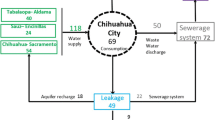Abstract
Managed aquifer recharge (MAR) is used for drinking water quality improvement in Finland. Finnish lakes are typically humic-containing natural organic matter (NOM). A typical MAR plant includes infiltration of lake or river water into an unconfined esker aquifer and withdrawal of water from wells, a few hundred meters downstream. The infiltrated water should have a residence time of at least around 1 month before withdrawal to provide time for processes needed to break down or remove NOM. Since 1979, Tuusula Region Water Utility (TRWU) has produced drinking water from lake water using managed aquifer recharge. TRWU operates two MAR plants which do not use precipitation and disinfection chemicals. Raw water is infiltrated without any pretreatment. TRWU has experience from basin, sprinkling, and well infiltration. NOM is reduced from 7.7 to 2.1–2.6 mgTOC/l before abstraction of the water from wells. Abstracted water is post-treated by limestone filtration and disinfected by ultra-violet radiation before pumping for distribution. A specific feature of the MAR process is the delayed influence of the raw water temperature on the abstracted water temperature. Design and operational experiences of the MAR plants are presented and discussed. Special emphasis is given for NOM reduction, temperature effects, comparison of infiltration techniques, and costs.









Similar content being viewed by others
References
Dillon P, Fernandez EE, Tuinhof A (2012) Management of aquifer recharge and discharge processes and aquifer storage equilibrium. IAH contribution to GEF-FAO groundwater governance thematic paper 4, p 49
Helmisaari HS, Derome J, Hatva T, Illmer K, Kitunen V, Lindroos A-J, Miettinen I, Pääkkönen J, Reijonen R (2005) Artificial recharge in Finland through basin and sprinkling infiltration: soil processes, retention time and water quality. In: Recharge systems for protecting and enhancing groundwater resources, proceedings of the 5th international symposium on management of aquifer recharge, ISMAR5, Berlin, Germany, 11–16 June, 2005. UNESCO IHP-VI, series on groundwater no. 13, pp 617–623
Jensen KH (2001) Introduction to the concept of artificial recharge. In: Artificial recharge of groundwater. EC project ENV4-CT95-0071. Energy, environment and sustainable development. Final Report, pp 9–11
Jokela P, Kallio E (2015) Sprinkling and well infiltration in managed aquifer recharge for drinking water quality improvement in Finland. J Hydrol Eng 20(3):B4014002-1–B4014002-7. doi:10.1061/(ASCE)HE.1943-5584.0000975
Jokela P, Vaahtera M, Vuori T, Meriluoto J (2007) The effect of iron and aluminium chemicals in humic water treatment by high-rate dissolved air flotation. In: Hahn HH, Hoffman E, Ødegaard H (eds) Chemical water and wastewater treatment IX, proceedings of the 12th Gothenburg symposium, Ljubljana, Slovenia, 20–23 May, 2007. IWA Publishing, London, pp 221–229
Jokela P, Eskola T, Heinonen T, Tanttu U, Tyrväinen J, Artimo A (2017) Raw water quality and pretreatment in managed aquifer recharge for drinking water production in Finland. Water 9:138. doi:10.3390/w9020138
Jørgensen C, Peters J, Eschweiler B (2001) Removal of pathogens and monitoring of microbial changes during artificial recharge. In: Artificial recharge of groundwater. EC project ENV4-CT95-0071. Energy, environment and sustainable development. Final Report, pp 221–225
Kolehmainen R (2008) Natural organic matter biodegradation and microbial community dynamics in artificial groundwater recharge. Doctoral Dissertation. Tampere University of Technology, Tampere, Finland, Publication 781
Kolehmainen RE, Langwaldt JH, Puhakka JA (2007) Natural organic matter (NOM) removal and structural changes in the bacterial community during artificial groundwater recharge with humic lake water. Water Res 41:2715–2725
Kolehmainen RE, Kortelainen NM, Langwaldt JH, Puhakka JA (2009) Biodegradation of natural organic matter in long-term, continuous-flow experiments simulating artificial ground water recharge for drinking water production. J Environ Qual 38:44–52
Kortelainen NM, Karhu JA (2001) Stabiilien isotooppien hyödyntäminen tekopohjaveden muodostamisessa ja ranta-imeytymisessä: Tuusulan ja Forssan pohjavesialueet (Use of stable isotopes in managed aquifer recharge and bank filtration: Tuusula and Forssa aquifers). In: Salonen V-P, Korkka-Niemi K (eds) Kirjoituksia pohjavedestä. University of Turku, Finland, pp 95–106. (In Finnish)
Kortelainen NM, Karhu JA (2006) Tracing the decomposition of dissolved organic carbon in artificial groundwater recharge using carbon isotope ratios. Appl Geochem 21:547–562
Lahti K, Rapala J, Kivimäki A-L, Kukkonen J, Niemelä M, Sivonen K (2001) Occurrence of microcystins in raw water sources and treated drinking water of Finnish waterworks. Water Sci Technol 43(12):225–228
Mattsson T (2010) Export of organic matter, sulphate, and base cations from boreal headwater catchments downstream to the coast: impacts of land use and climate. Monographs of the Boreal Environment Research, no. 36, 2010. ISBN 978-952-11-3759-4
Medema GJ, Stuyfzand PJ (2002) Removal of micro-organisms upon basin recharge, deep well injection and river bank filtration in the Netherlands. In: Dillon P (ed) Management of aquifer recharge for sustainability. Proceedings of the 4th international symposium on artificial recharge of groundwater, Adelaide, September, 2002, Lisse, Netherlands, ISBN 9058095274, pp 125–131
Rantakari M (2010) The role of lakes in carbon cycling in boreal catchments. Monographs of the Boreal Environment Research, no. 35, 2010. ISBN 978-952-11-3744-0
Standard Methods (1998) Standard methods for the examination of water and wastewater, 20th edn. APHA/AWWA/WEF, Washington DC
Zacheus O (2011) Yhteenveto keskisuurten laitosten talousveden valvonnasta vuonna 2010 (Summary of water quality and control of middle-sized waterworks in 2010). National Institute for Health and Welfare. http://www.valvira.fi/documents/14444/22511/Talousvesi_Keskisuuret_2010_Tiivistelma_Toimiva.pdf. Accessed 7 Apr 2017. (In Finnish)
Zacheus O (2015) Yhteenveto suurten laitosten talousveden valvonnasta vuonna 2015 (Summary of water quality and control of large-sized waterworks in 2015). National Institute for Health and Welfare. http://www.valvira.fi/documents/14444/249256/2015+Yhteenveto+EU-vedenjakelualueiden+valvonnasta+ja+laadusta/651856d2-e57e-40cb-bc6d-901589b0165b. Accessed 7 Apr 2017. (In Finnish)
Author information
Authors and Affiliations
Corresponding author
Additional information
This article is part of the special issue on Managed Aquifer Recharge.
Rights and permissions
About this article
Cite this article
Tanttu, U., Jokela, P. Sustainable drinking water quality improvement by managed aquifer recharge in Tuusula region, Finland. Sustain. Water Resour. Manag. 4, 225–235 (2018). https://doi.org/10.1007/s40899-017-0198-0
Received:
Accepted:
Published:
Issue Date:
DOI: https://doi.org/10.1007/s40899-017-0198-0




